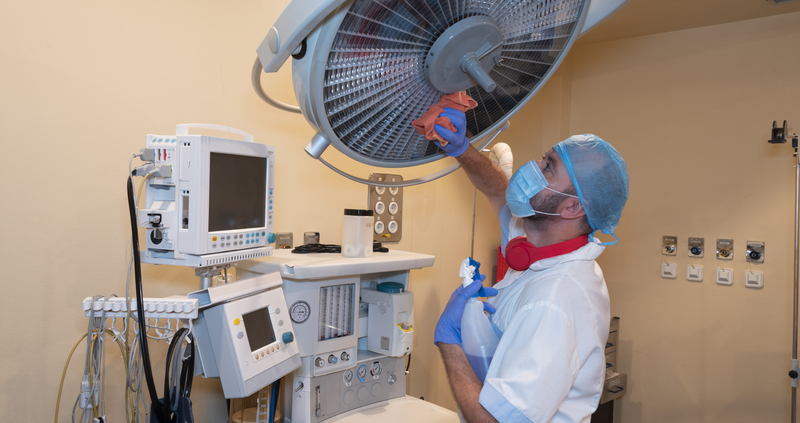Three Levels of Decontamination For Infection Control
In this post we’ll explore each of these levels of decontamination in turn, discussing the procedures involved, and when they’d apply in a hospital or healthcare setting.
What Are The Three Levels of Decontamination For Infection Control
There are three levels of decontamination for infection control:
- Cleaning
- Sterilisation
- Disinfection
Healthcare Equipment Risk Levels
All healthcare equipment carries a different level of contamination risk, and this level determines the appropriate decontamination procedure:
- Low Risk – Items that will only come into contact with intact skin, or which will not come into contact with the patient at all. Examples include furniture, floors, bedding, clothing, and IV pumps.
- Medium Risk – Items that will come into contact with the patient’s intact mucous membranes. Also, items that are likely to be contaminated with virulent or transmissible organisms, and any item that might be used on an immunocompromised patient.
- High Risk – Items that will penetrate a patient’s skin or mucous membrane, or enter the vascular system. Also, any item taken into a sterile space must be considered high risk.
Cleaning is usually sufficient for decontaminating low risk items. Medium risk items will have to be either disinfected or sterilised before use. High risk items need to go through the complete process – cleaning, disinfection and sterilisation.
When Should Medical Decontamination Procedures Take Place?
Reusable medical equipment should be decontaminated after it’s been used on a patient, and before it’s used on another patient. Following decontamination, equipment should be labelled and dated to confirm that it’s clean and ready for use.
Different departments might have to follow different cleaning procedures and protocols, depending on the sort of patients they treat, and the sort of treatments they carry out. An operating theatre, for example, will have to follow much more stringent cleaning procedures than a waiting room.
Also, decontamination is just one of 10 standard infection control precautions (SICPs) that hospitals and healthcare settings should follow. Read our full guide to the 10 SICPs.
Cleaning
Cleaning is the lowest level of decontamination, but it’s still vitally important for preventing and controlling infection. It essentially involves using a mix of water, detergents, and friction to remove dirt and organic matter from surfaces and objects.
Cleaning removes microbes, but it doesn’t necessarily kill them. So any object that might be used as part of an invasive procedure will have to be disinfected or sterilised after being cleaned.
To be considered “clean”, all visible signs of soiling must be removed. Medical equipment should be “visibly clean” before it’s ready for use.
We have detailed guides to cleaning procedures suitable for different areas of the hospital:
- Cleaning for infection control in waiting rooms and GP clinics.
- Cleaning for infection control in operating theatres.
Disinfection
Disinfection involves using chemicals, heat, or UV radiation to reduce the number of microbes on an object. While disinfection won’t remove every microbe on an object, it can reduce the number of microbes to a level at which they do not pose an infection risk.
Items must be clean – that is, “visibly clean” – before they’re ready for disinfection.
Standard disinfection procedures do not kill spores. Sterilisation is necessary to remove spores from an object.
Sterilisation
Sterilisation processes can remove all microbes from an object, including spores. It involves making use of chemicals such as ethylene oxide or hydrogen dioxide, or specialist equipment, such as an autoclave.
In order for an item to be considered “sterilised”, then all microbes must have been removed or destroyed. And as with disinfection, items must be thoroughly cleaned before they’re sterilised.
For more information about the three levels of decontamination, and how they might apply in practice in a healthcare setting, take a look at this official NHS guidance.
Effective Decontamination For Infection Control in Hospitals
We stock a full range of highly effective hospital cleaning and containment products, including the powerful Virusolve+ range of wipes and concentrates. Browse our complete range of infection control products.
The chemicals used in decontamination procedures can be toxic. So hospitals must comply with the Control of Substances Hazardous to Health (COSHH) Regulations wherever these chemicals are used.
An air quality consultation will help you identify the exposure risks for staff and patients alike. Following the consultation, you’ll get a detailed report and actionable advice on the measures you can take to improve the air quality in your hospital.
A hospital grade air purifier can help you quickly and thoroughly improve the air quality in your hospital or healthcare setting. Our Blueair HealthProtect air purifiers are fitted with advanced HEPASilent technology. This is capable of catching 99.97% of particles down to 0.1 microns.
Take a look at our specialist air purification systems for hospitals.



